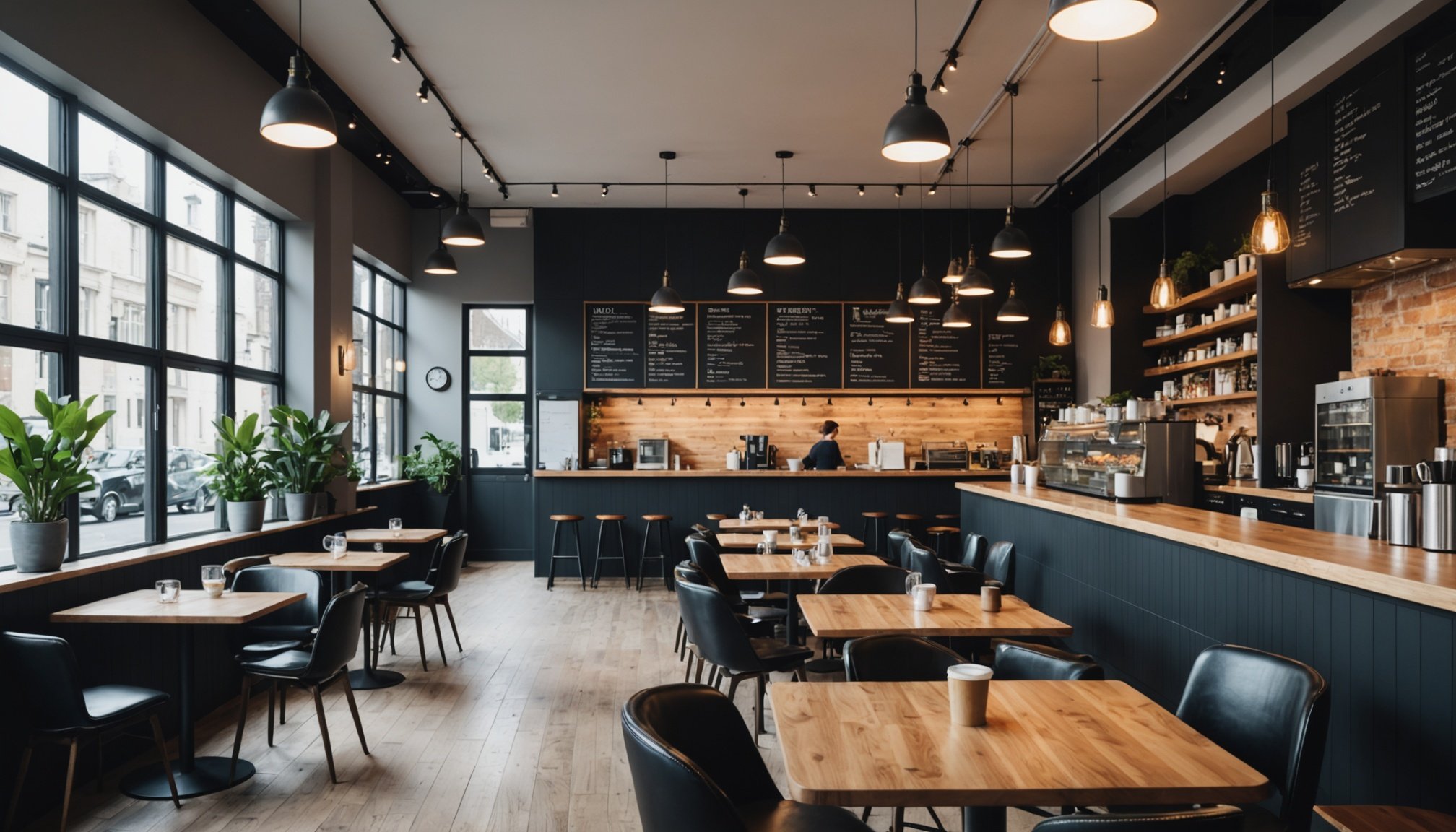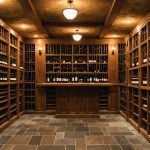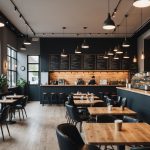Designing a café goes beyond aesthetics; it involves creating an inviting atmosphere that enhances customer experience. This guide will help you understand the balance between functionality and beauty, ensuring every element serves a purpose while captivating your clientele. Explore key principles, from layout and lighting to color palettes and furnishings, and discover how thoughtful design choices can transform your café into a haven for coffee lovers and socializers alike. Let's embark on this journey to manifest your ideal café!
Understanding Café Design Principles
Exploring the world of café aesthetics reveals the intricate dance between visual appeal and practicality. A successful café design hinges on a harmonious blend of aesthetics and functionality. This balance ensures that while the café is visually inviting, it remains a practical space for both customers and staff.
In the same genre : Top tips for protecting your bar”s wine cellar from spoilage: strategies for wine preservation
Key elements of café design include lighting, layout, and furniture. Each plays a pivotal role in creating an environment that is both welcoming and efficient. Consider the layout: it must facilitate smooth movement for staff and comfort for patrons. This involves strategic placement of seating and service areas to optimize the flow of traffic.
Understanding the target audience is crucial. A café catering to young professionals might emphasize sleek, modern designs with ample charging stations, while a family-oriented café might prioritize spacious seating and child-friendly features. This understanding directly impacts the overall customer experience.
Also read : Uncover the best pest management tips to ensure your rural gastropub thrives
Design Elements to Consider
- Lighting: Natural and artificial lighting should work together to create a warm atmosphere.
- Seating: Varied seating options cater to different customer needs.
- Acoustics: Sound control enhances the ambience, ensuring conversations are private yet audible.
Incorporating these elements thoughtfully can transform a simple café into a beloved community hub, where both aesthetics and functional spaces are celebrated.
Layout Planning for Efficiency
Exploring the intricacies of café layout planning involves more than just arranging tables and chairs. It's about crafting a space that maximizes efficiency and enhances the overall customer experience.
Optimizing Space and Traffic Flow
A well-thought-out café layout ensures smooth traffic flow, minimizing congestion and wait times. This involves strategic placement of ordering counters, seating areas, and paths for staff movement. For instance, separating the ordering and pickup zones can streamline operations and reduce bottlenecks.
Zoning for Activities
Effective space management includes zoning different areas for specific activities. Consider creating distinct zones for ordering, dining, and lounging. This not only optimizes traffic flow but also caters to diverse customer needs. For example, a cozy reading nook can attract patrons looking for a quiet escape, while a communal table fosters social interaction.
- Ordering Zone: Fast service and clear signage
- Seating Zone: Varied seating for diverse preferences
- Lounge Area: Comfortable and inviting
Flexibility in Layout Design
The importance of flexibility in café layout cannot be overstated. As customer preferences evolve, so should the space. Modular furniture and adaptable layouts allow for easy reconfiguration, ensuring the café remains relevant and efficient. By prioritizing space management and flexible design, a café can adapt to changing needs while maintaining optimal traffic flow.
Interior Décor Ideas
Exploring café themes and design inspiration can transform a space into a memorable destination. The choice of interior décor is pivotal in setting the tone and ambiance for patrons.
Popular Décor Styles
Different styles resonate with diverse audiences. Modern cafés often feature clean lines and minimalistic elements, appealing to those seeking a contemporary vibe. In contrast, a vintage theme might incorporate retro furniture and nostalgic accents, creating a sense of warmth and familiarity. Rustic designs, with their use of natural materials and earthy tones, evoke a cozy, inviting atmosphere.
Incorporating Local Culture
Infusing local culture and art into the café's design can enhance its unique appeal. This might include displaying works by local artists or using motifs and colors that reflect the community's heritage. Such thoughtful touches not only enrich the interior décor but also foster a deeper connection with the clientele.
Textures and Materials
The use of varied textures and materials is essential in crafting the desired ambiance. Combining elements like wood, metal, and textiles can add depth and interest to the space. For instance, exposed brick walls paired with plush seating can create a balanced mix of industrial and comfort.
- Modern: Sleek, minimalistic
- Vintage: Retro, nostalgic
- Rustic: Natural, cozy
Incorporating these ideas ensures a captivating and cohesive design.
Selecting the Right Furniture
Choosing the perfect café furniture requires careful consideration of both comfort and functionality. These elements are crucial in ensuring that patrons feel welcome and at ease, while also maintaining a practical space for everyday operations.
Criteria for Furniture Selection
Selecting functional and comfortable furniture involves evaluating several key factors. Durability is essential; café furniture must withstand frequent use and potential spills. Additionally, maintenance should be straightforward to ensure longevity and cleanliness. Aesthetic appeal cannot be overlooked, as it contributes to the overall ambiance.
- Durability: Long-lasting materials
- Maintenance: Easy to clean
- Aesthetics: Complementary to the design
Balancing Aesthetics with Durability
Striking a balance between aesthetics and durability is vital. Opt for materials like metal or treated wood that offer both visual appeal and resilience. Consider upholstery fabrics that are both stylish and easy to maintain. This ensures that the café remains inviting while minimizing long-term maintenance costs.
Arranging for Optimal Flow
Arranging café furniture strategically enhances customer flow and comfort. Ensure that seating arrangements allow for easy movement and accessibility. Consider diverse seating options, such as booths, communal tables, and individual chairs, to cater to varied customer preferences. This thoughtful layout not only improves the customer experience but also optimizes space utilization.
Color Schemes and Their Impact
Exploring the psychological effects of color in café design reveals how hues can transform a space's atmosphere. Colors evoke emotions and influence behaviors, making color schemes vital in creating a desired mood. Warm tones like reds and oranges can stimulate conversation and energy, ideal for bustling areas. In contrast, cool blues and greens promote relaxation, perfect for a café atmosphere that encourages lingering.
Choosing a cohesive color palette is essential for branding. A well-thought-out palette not only enhances visual appeal but also strengthens brand identity. Harmonious colors create a seamless experience, tying together the café's design elements. For instance, a café with a modern aesthetic might opt for monochrome schemes with bold accents, while a vintage café could use muted pastels for a nostalgic feel.
Using color strategically enhances different areas of the café. Bright, inviting hues can define the ordering zone, drawing attention and facilitating quick decisions. Softer tones in seating areas can encourage comfort and longer visits.
- Warm Colors: Stimulate energy
- Cool Colors: Promote relaxation
- Neutral Colors: Provide balance
By understanding and applying the psychological effects of color, café owners can craft an engaging and cohesive café atmosphere that resonates with patrons.
Lighting Techniques for Ambiance
Exploring the nuances of café lighting reveals its pivotal role in crafting a welcoming atmosphere. Effective lighting involves a strategic blend of layered lighting, which includes ambient, task, and accent lighting.
Ambient lighting serves as the primary source of illumination. It creates a warm, inviting atmosphere that sets the tone for the entire café. Task lighting focuses on specific areas, such as ordering counters or reading nooks, providing adequate brightness for activities. Accent lighting highlights architectural features or artwork, adding depth and interest to the space.
Creative Ways to Incorporate Natural Light
Incorporating natural light can significantly enhance a café's ambiance. Large windows or skylights can flood the space with sunlight, creating a vibrant and airy environment. Mirrors strategically placed opposite windows can amplify natural light, making the space feel larger and more open.
Lighting Solutions for Different Times of Day
Adjusting lighting throughout the day ensures a consistent ambiance. In the morning, bright, energizing lights can invigorate patrons. As evening approaches, dimmer, warmer lights can create a cozy, intimate setting.
- Morning: Bright and energizing
- Afternoon: Balanced and even
- Evening: Warm and cozy
By mastering these lighting techniques, café owners can create an inviting atmosphere that enhances the overall customer experience.
Creating a Welcoming Atmosphere
Crafting the perfect café atmosphere requires attention to detail and a commitment to enhancing the customer experience.
Elements of a Welcoming Environment
A successful café atmosphere is built on several key elements. Scent, sound, and service play crucial roles in shaping the overall ambiance. Consider the aroma of freshly brewed coffee or baked goods, which can instantly create a warm and inviting environment. Gentle background music can enhance the mood without overwhelming conversations, while attentive service ensures patrons feel valued and comfortable.
Importance of Scent, Sound, and Service
The sensory experience in a café is pivotal. A pleasant scent can evoke positive emotions and encourage longer visits. Sound management, including music selection and volume, contributes to a relaxing and enjoyable space. Exceptional service is the cornerstone of a memorable customer experience, fostering loyalty and repeat visits.
- Scent: Inviting aromas
- Sound: Relaxing music
- Service: Attentive staff
Utilizing Community Engagement
Engaging with the local community can elevate the café atmosphere. Hosting events or featuring local artists can create a sense of belonging and connection. This not only enriches the customer experience but also builds a loyal customer base. By integrating these elements, a café can craft an ambiance that resonates with patrons and stands out as a cherished community space.











